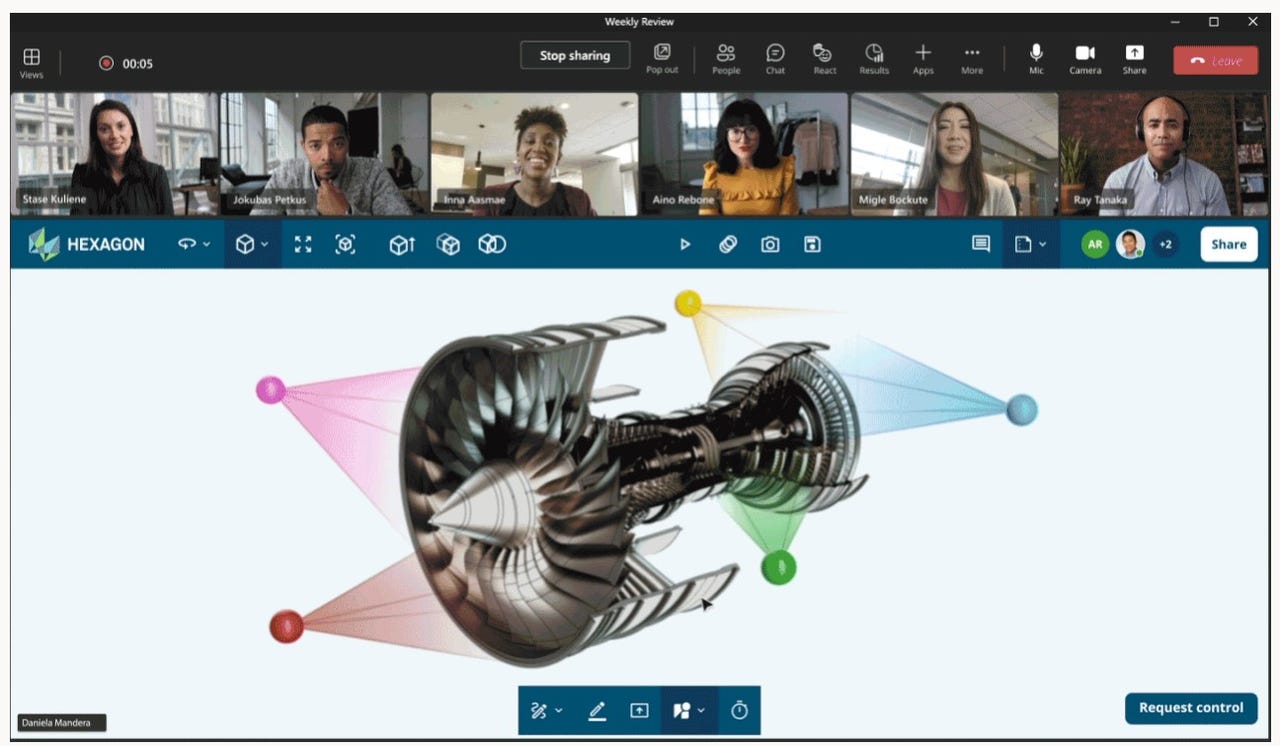































 Credit: Microsoft
Credit: Microsoft Among the 50 new product and technology announcements at Microsoft's Build 2022 developers conference are several new tools and functionality for Teams and Power Platform developers.
Teams is getting a new feature called "Live Share," which will allow apps to go beyond passive screen sharing and enable participants to watch, edit/annotate and create together inside of Teams meetings. Developers can use new extensions in preview for the Teams Client software development kit (SDK) to extend existing Teams apps and create Live Share scenarios in meetings.
Live Share in Teams is not the same as Live Share in Visual Studio; the two technologies with the same name are built on top of different technology stacks. Live Share in Teams is built on top of the Fluid Framework. Teams hosting and managing runs on the Azure Fluid Relay service. Officials said in 2017, when Live Share for Visual Studio was introduced, that the technology was built "from the ground up" but informed by collaboration technology in Office.
Fluid Framework is Microsoft's fast co-authoring and embedding technology. Azure Fluid Relay is the cloud service that supports Fluid Framework Clients. Today at Build, officials said Fluid Framework, the Azure Fluid Relay service and corresponding Azure Fluid client-side SDK will be ready for production scenarios and available in summer 2022.
One of Microsoft's newer technologies that relies on Fluid Framework is Loop. Microsoft introduced the Loop components concept last year and showed off an early version of its Loop collaboration app, which is similar to Notion. A spokesperson said Microsoft will have more to say about the Loop app and pages "in the upcoming months."
But next month, developers will be able to start developing their own Loop components by using existing Adaptive Cards or building new ones. Adaptive Cards are an open card exchange format enabling developers to exchange UI content in a common and consistent way. Officials said Zoho is using Adaptive Card-based Loop components inside Teams and Outlook. Other developers can try this out in a private preview starting in June.
Teams developers also can upgrade to the Teams JS SDK v2 and App Manifest v1.13 to extend personal tabs of their Teams apps to work on Office and Office.com. Teams, Office and Office.com are all considered "hubs" in Microsoft's internal MetaOS world view, and the company's goal is to enable developers to write an app once and run it across any of the Microsoft hubs on which customers choose to focus.
On the Power Apps front, Microsoft announced, as expected, that it is rebranding Power Apps portals as Power Pages. Power Apps Portals is a development and hosting platform for building business-centered websites. Low-code developers can use Portals to publish sites for desktop and mobile and have the option of using customizable templates to build these sites.
Instead of being classified as a feature within Power Apps, Power Pages will become the fifth member of the Power Platform family as a standalone offering within the Power Platform portfolio. As part of its launch of the Power Pages brand, Microsoft has redesigned the UI, added integrations with Visual Studio, GitHub and Azure DevOps, and spiffed-up the templates.
Microsoft also announced a new Power Apps feature called Express Design, which allows developers to turn images, docs, Figma design files and PowerPoints into apps by using Microsoft cognitive AI tech to scan the inputs and produce working app controls backed with data storage. And Microsoft is adding a new Power Automate pay-as-you-go plan and updates to the embedded SDK so that developers, customers and ISVs can embed Power Automate in third-party apps but only pay for what they use.
Microsoft also announced today Collaboration Controls in Power Apps, which lets developers drag and drop Microsoft 365 collaboration features like Teams chats, meetings, files, Tasks and more inside custom apps built with Power Apps. Collaboration Controls will be available in preview later this summer.
 Etiquetas calientes:
tecnología
Servicios y Software
Etiquetas calientes:
tecnología
Servicios y Software